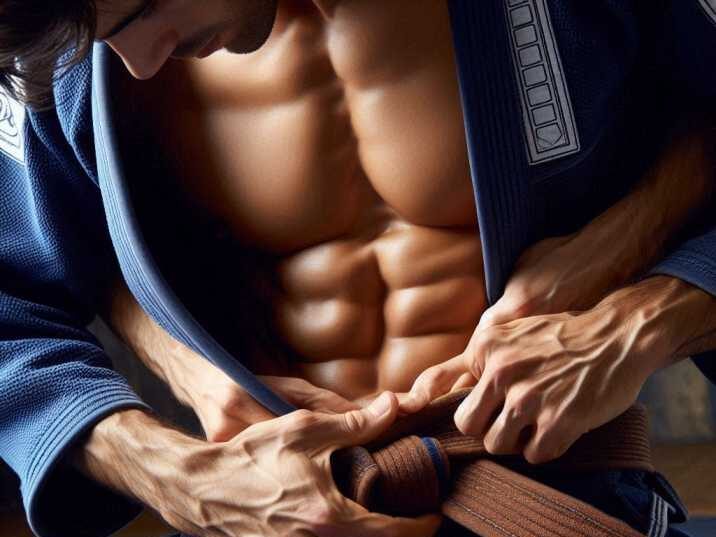Introduction
Table of Contents
Brazilian Jiu Jitsu (BJJ) is a martial art that focuses on grappling and ground fighting. It has a structured belt ranking system that signifies a practitioner’s skill and experience level. Among these ranks, the brown belt is one of the highest, just one step away from the prestigious black belt. Achieving a brown belt in Jiu Jitsu requires years of dedication, training, and mastery of advanced techniques.
In this article, we will explore what a brown belt in BJJ means, the skills required, how long it takes to earn one, and the responsibilities of a brown belt practitioner.

What Does a Brown Belt in Jiu Jitsu Represent?
A brown belt in BJJ is considered an expert level. It signifies that a student has a deep understanding of techniques, strategies, and practical application. A brown belt practitioner is expected to refine their skills, teach lower belts, and prepare for the black belt promotion.
Key Characteristics of a Brown Belt in Jiu Jitsu
- Technical Mastery
A brown belt in BJJ has developed a deep understanding of advanced techniques in both offense and defense. They can seamlessly transition between positions, execute complex submissions, and defend against skilled opponents. Their movements are precise, efficient, and well-refined, demonstrating years of dedicated training.
- Strategic Thinking
At this level, a BJJ brown belt is not just reacting but anticipating their opponent’s moves. They develop advanced strategies for competitions and real-world self-defense situations. They understand timing, leverage, and counters, allowing them to stay one step ahead in a match or sparring session.
- Teaching Ability
A key responsibility of a brown belt is mentoring lower-ranked students. They assist instructors, help explain techniques, and offer guidance during training sessions. Teaching enhances their own skills, reinforcing their knowledge while fostering a supportive learning environment in the gym.
- Physical and Mental Toughness
Reaching the brown belt level requires both physical endurance and mental resilience. Training is intense, demanding excellent conditioning and strength. Mentally, brown belts develop perseverance, patience, and the ability to handle challenges, preparing them for the final step toward a black belt.
How Long Does It Take to Earn a Brown Belt in Jiu Jitsu?
On average, it takes 7-10 years to reach the brown belt level in BJJ. However, the timeline varies based on factors like training frequency, dedication, and competition experience.
Factors Affecting Promotion Speed.
- Training Consistency
Practicing 3-5 times per week helps students develop muscle memory, improve techniques, and build endurance. Regular training ensures steady progress and deeper understanding of Jiu Jitsu concepts. Those who train consistently are more likely to advance faster compared to those who train sporadically.
- Competition Performance
Competing in BJJ tournaments provides real-world experience, tests problem-solving skills, and sharpens techniques under pressure. Success in competitions demonstrates skill level, adaptability, and confidence, which can influence a coach’s decision to promote a student sooner.
- Instructor’s Assessment
A student’s progress is evaluated based on technical ability, attitude, and leadership qualities. Instructors look for precision in techniques, effective execution in sparring, and a strong understanding of BJJ principles. Dedication, respect, and a willingness to help others also contribute to promotion speed.
Skills Required to Earn a Brown Belt
A BJJ brown belt must demonstrate mastery over several key areas:
1. Advanced Guard Techniques
- Spider Guard: A versatile guard that utilizes sleeve grips and foot placement to control an opponent’s posture and set up sweeps or submissions.
- De La Riva Guard: A dynamic open guard used to off-balance opponents, leading to powerful sweeps and transitions to back control.
- Reverse X-Guard: A highly technical guard that provides excellent leg control, allowing for effective sweeps and leg lock setups.
2. Submission Chains
- Triangle Choke to Armbar Transitions: A seamless combination where a failed triangle choke can be quickly converted into an armbar, keeping continuous offensive pressure.
- Omoplata to Kimura Combinations: A chain attack where a submission attempt with an omoplata can transition into a kimura lock for added versatility.
- Leg Lock Entries and Defenses: A brown belt must know how to execute and counter leg locks, including heel hooks, ankle locks, and knee bars.
3. Escapes and Defenses
- Countering Chokes and Joint Locks: Recognizing and neutralizing threats from guillotines, rear-naked chokes, armbars, and kimuras before they are fully applied.
- Sweeping from Bottom Positions: Using leverage and technique to off-balance and reverse an opponent from guard positions like butterfly, half-guard, and closed guard.
- Escaping Side Control and Mount: Mastering hip escapes, bridge-and-roll techniques, and frames to regain guard or standing position against controlling opponents.
4. Teaching and Leadership
- Helping Lower Belts Improve: Brown belts mentor and guide lower ranks, offering insights on technique and strategy to help them progress.
- Assisting in Class Instruction: Many brown belts help lead warm-ups, demonstrate techniques, and correct students’ form, preparing them for future teaching roles.
- Understanding BJJ Philosophy and Ethics: At this level, practitioners gain deeper respect for the art, emphasizing humility, discipline, and lifelong learning.
Challenges of a Brown Belt in Jiu Jitsu
Mental and Physical Challenges
- High Expectations: As a brown belt, the bar is set high. Coaches and peers expect precision in technique, leadership in training, and a commitment to continuous improvement, making it crucial to stay disciplined and dedicated.
- Injury Risk: Training intensity increases at this level, leading to a higher chance of injuries. Sparring with skilled opponents and refining high-level techniques require excellent body awareness, recovery strategies, and injury prevention.
- Balancing Teaching and Training: Brown belts often take on mentoring roles while still advancing their own skills. Learning to teach effectively while maintaining personal growth requires time management, patience, and adaptability.
Brown Belt to Black Belt Transition
A brown belt is the final step before achieving a black belt in BJJ. This transition requires:
- Consistent Training
- Continued Competition Experience
- Demonstrating Leadership and Sportsmanship
BJJ Belt Ranking System
The Brazilian Jiu Jitsu belt system consists of several ranks, each representing a different skill level. Below is a breakdown:
| Belt Rank | Minimum Age | Average Time to Earn | Skill Level |
|---|---|---|---|
| White Belt | No age limit | 0-1 year | Beginner |
| Blue Belt | 16+ years | 2-3 years | Intermediate |
| Purple Belt | 16+ years | 2-3 years | Advanced |
| Brown Belt | 18+ years | 1-2 years | Expert |
| Black Belt | 19+ years | 3+ years | Mastery |

Conclusion
A brown belt in Jiu Jitsu is a major milestone, marking the transition from student to expert. At this level, practitioners refine techniques, develop leadership skills, and prepare for the final step to black belt. Through consistent training, competition, and mentorship, brown belts solidify their legacy in Brazilian Jiu Jitsu.
FAQs
1. How long does it take to get a brown belt in Jiu Jitsu?
It typically takes 7-10 years of consistent training to earn a brown belt in BJJ.
2. Can a brown belt beat a black belt?
Yes, in some cases. Skill, strategy, and physical conditioning play a huge role in a match, regardless of rank.
3. Is a brown belt considered an expert in BJJ?
Yes, a brown belt is considered highly skilled and knowledgeable in Brazilian Jiu Jitsu.
4. Do brown belts teach Jiu Jitsu?
Yes, brown belts often assist in teaching lower-ranked students and leading training sessions.
5. What is the hardest part of reaching a brown belt?
Maintaining discipline, consistency, and physical conditioning while balancing teaching responsibilities.


